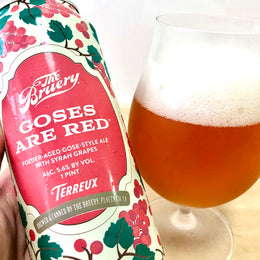
The exact origin of the term "steam beer" is a bit of a mystery, and there are several theories about its origin. One popular theory is that it's related to the steam that was seen coming off the beer during the brewing process. But like many tales steeped in history, the truth is often a blend of fact, fiction, and the foggy memories of those who've had one pint too many.

It became popular during the California Gold Rush, a time when San Francisco was a melting pot of ambition, desperation, and innovation. The city was teeming with blue-collar workers, miners who had dreams of striking gold, and labourers who built the very foundations of the modern West Coast. For these hardworking souls, a cold beer at the end of a gruelling day wasn't just a luxury; it was a necessity. But there was a problem. Traditional lagers, beloved by many, required colder temperatures for fermentation, a luxury not easily afforded in the ice-scarce world of 19th-century California.


In the spirit of the Gold Rush, brewers got inventive. Without the convenience of refrigeration, they turned to the elements themselves. Open-top fermentation became the order of the day at steam beer breweries (including the brewery that would later become Anchor Brewing Company). As the sun dipped below the horizon, the cool San Francisco evening air rolled in and danced across the fermenting beer on the rooftop of breweries. This natural cooling process, combined with the warmth of the beer, would produce a mesmerising visual: steam rising from the brewery rooftop, as if the building itself was exhaling the day's hard work.

Like many craft products, what was a pragmatic brewing method born out of necessity became an art form to the brewer. The brewer claims that this unique neither-lager-nor-ale process imparted to the beer a unique character, marrying the crispness of a lager with the richness of an ale.
Today, Anchor Brewing Company owns the rights to the term "Steam Beer", while other craft breweries making the same style would refer to theirs as "California common beer". Anchor is also one of the oldest craft breweries in the US, having operated for over 150 years and was arguably a key figure in the early US craft beer movement in the 60s and 70s, creating the Liberty Ale in 1975 which anticipated the IPA boom and popularity of dry-hopped beers.

Yet, it's with heavy hearts that we bid this San Francisco icon farewell as its doors have been shut forever this year, marking the end of an era. Despite surviving world wars, the Great Depression and the Great Recession, its current Japanese owner, Sapporo USA, cited competition from other craft brewers, hard seltzer brands and heavy losses from COVID-19 that sounded the financial death knell for the brewer.

While Anchor would no longer be brewing, as of the date of writing, many of its beers are still available for purchase in supermarkets and beer stores around the world. We felt it would be fitting to have a taste of this icon and raise a glass to its unique history. Without sounding corny at all, this is without a doubt a drink that tells a story of San Francisco and its early people, and of innovation in the face of challenges.
Anchor Steam Beer (California Common Beer), 4.9% ABV – Review

Appearance: Beautiful coppery amber.
Nose: Green hops come through immediately, followed by subtle floral undertones. There's a faint sweetness, reminiscent of old school jelly cups.
Palate: Very crisp and refreshing, with a fairly light mouthfeel. The first sip gives you a noticeable acidic tang, akin to the zesty bite you'd get from a San Pellegrino Limonata lemonade soda. Underneath that, there are hints of light caramel and a touch of honey, paired with biscuity undertones. The presence of hops can be felt but they don't bring any significant bitterness you might expect.
Finish: Clean and malty with an evident barley backbone reminiscent of many of the lagers I like. As it settles, there's a gentle emergence of hop character, but it's more on the woody, piney, rustic side rather than the unbridled bitterness you'd find in an IPA or pale ale. Towards the end, there's a hint of mintiness, a pleasant surprise.

My Thoughts:
This beer is quite light and straightforward and doesn't try to be something it's not. It's not super flavourful for a craft beer but it's incredibly easy to drink, and I appreciate that.
It's slightly more on the sweet side than bitter, and neither the malts nor the hops take centre stage, which is probably why it's so approachable. The carbonation level is just right, adding to its refreshing nature.
It's a decent brew, especially if you're looking for something at a casual party that won't demand too much of your attention.

@CharsiuCharlie







